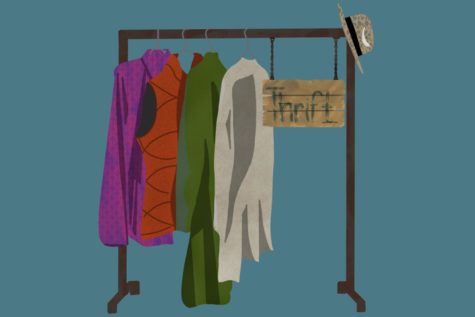OPINION | Embracing sustainable shopping in New Orleans
April 5, 2022

Returning from spring break, the summer months are not far away. Plans of traveling, internships and relaxing long weekends can feel like the light at the end of the tunnel during the final stretch of classes. This anticipation of new experiences, or just the mere changing of seasons, also makes the end of the school year a time for shopping.
Although an exciting time, summer comes with unignorable reminders of the climate crisis we are facing. Aside from the grueling heat, New Orleans saw its rainiest summer since 1947, when recording began, in 2017.
Hurricane-wise, the city endured a “record-setting sixth consecutive year with an above normal number of tropical events, even after the agency raised its averages for storms in a normal season.”
Between the increasingly frequent severe weather, rising temperatures and fear of rising water lines, students at Tulane University should be particularly aware of the impacts that climate change will continue to have on our part-time home.
Fast fashion is only one of the many contributors to climate change. Sustainability activists stress that change must come from government regulation and corporate initiatives. Activists also acknowledge that it is unreasonable to put the burden of shopping sustainably solely on consumers.
However, governments act slowly to put climate protective policies in place, despite the urgency of the current climate crisis.
Companies that profit off of wasteful consumerism will likely act even more slowly in implementing these policies, especially as corporations perfect their greenwashing tactics.
College students are not expected to solve the climate crisis, but making small changes in the way we shop can make a difference and bring a refreshing change of pace. In Uptown New Orleans alone, students have many options for sustainable shopping.
Just a few blocks down from Newcomb Hall on Oak Street, there is a strip of local shops, restaurants and studios. One of these is Glue Clothing Exchange, where you can shop for second-hand clothes and also trade in your old pieces for store credit.
Further down is Ma Petite Boutique, which also offers second-hand clothes and has a large collection of women’s accessories to shop from.
A short streetcar ride brings you to Magazine Street, where there are blocks of restaurants and shopping options. Buffalo Exchange is a thrift store with locations in many big cities, and its New Orleans location has plenty of racks with clothes of all different styles and sizes. Buffalo Exchange is another option for those looking to sell clothes, and they take walk-ins based on availability and offer appointments through their website.
On the higher end, Swap Boutique is an upscale, designer consignment store carrying clothes and accessories.
The list of thrift stores in New Orleans is extensive, each with an entirely different inventory and unique items. There are also plenty of online options for sustainable shopping, including options for non-secondhand sustainable clothes as well as online thrift stores.
Lists of environmentally conscious companies can be found on different blogs and websites, which are helpful resources for those transitioning to sustainable shopping.
These sites have great collections, but they tend to be pricier since sustainably sourced materials and labor are more expensive, thus driving up the retail prices.
Websites such as Depop, Poshmark, and thredUP are all platforms where anyone can list clothes they are selling and buy from others. These platforms are great resources for those looking to make a little money by selling their clothes, and they also make it easy to buy second-hand clothes without having to look through racks upon racks in thrift stores.
Designer items are frequently listed on these platforms, but when purchasing an expensive piece online, you may question its authenticity. TheRealReal and ReBag are companies that inspect and authenticate items before listing them, ensuring that people are not paying high prices for counterfeit accessories and clothes.
Between local shops and online stores, there are plenty of sustainable stores offering various price points and styles. It is important to know that it is most sustainable to rewear and take care of the clothes you already own.
The concept of a capsule wardrobe has recently become popular, which entails building a medium-size collection of well-made, timeless pieces that can be paired with one another. Capsule wardrobes are the best way to maintain a sustainable wardrobe by focusing on purchasing clothes that can be worn for decades.
Whether you start thrifting, explore luxury consignment options or simply aim to buy clothes less frequently, small changes in the way we consume make an impact. Especially to Tulane students, being mindful of the environment should be especially relevant given the threats climate change poses to the city we are fortunate enough to live in.






















Leave a Comment